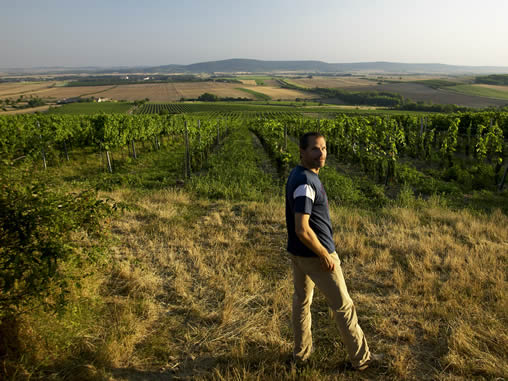|
Austrian
wines part 8
Graf
Hardegg

Peter Malberg (above) is someone who you only have to spend a
short time with to warm to. He’s not one of those superficially
charming people who say all the right things; rather, he’s quieter and
a bit deeper (but still fun). I enjoyed spending some time with him, tasting his wines.
Peter began working with the Graf Hardegg estate back
in 1993, and his wines have put the Weinvertel on the map as a region
capable of making quality wines: previously, the Weinvertel was just
thought of as a source of base wines for fizz and mass market plonk.
In short, it was considered rubbish. Part of the problem was
viticulture: the average farmer here has a 15 hectare smallholding,
and will grow just one or two hectares of vines.
The Weinvertel is an hour’s drive north of Vienna, on
the Czech border. It’s at the intersection of two climatic zones,
continental and pannonian, so it’s neither hot nor cold. It’s
quite changeable, so a good strategy is to grow a range of varieties,
knowing that it’s unlikely that every variety will thrive every
vintage. Hardegg has 43 hectares of vines split over five plots.
When Malberg started here he recognized that no one
really knew which were the best grapes for the region. Part of his
mission has been to experiment and work out which ones do best. The
experimental approach has led to the use of some varieties that
aren’t really grown in Austria, such as Syrah and Viognier. The lack
of a fine wine tradition in this region means that in a way, it’s
Austria’s new world.
We looked at a range of Hardegg wines, comparing the
older with the younger in a series flights.
Graf Hardegg Grüner Veltliner
Max 1994
Max was the term that Graff Hardegg used to use to indicate
reserve quality. This has an evolved nose with hints of sherry and a
savoury liminess. Unusual, savoury and intense. I don’t really like
it: Peter says it was made technically, with enzymes, dried yeast and
a cold ferment. Very good 83/100
Graf Hardegg Grüner Veltliner
2003
This was made with a longer, natural ferment; the vineyard is also
now in much better condition. Nice open, expressive nose with a
slightly herby edge to the bright, fresh, peppery fruit. The palate is
crisp and modern with lots of freshness and some character. Tasty.
Very good+ 88/100
Graf Hardegg Riesling Max 1997
The grapes were left outside as long as possible and this wine
correspondingly has 14% alcohol and 7 g/l residual sugar. This wine
wasn’t terribly drinkable in its youth. It has a rich, deep honeyed
nose with some apricotty richness. The palate is bold and full with a
dry-ish character. Very ripe and rounded; boldly flavoured and a good
match for Thai food, apparently. Very good+ 89/100
Graf Hardegg Riesling Steinbügel 2003
Bright fresh limey nose with a hint of pepperiness. The palate is
mineralic and expressive with nice savoury density. Crisp and fresh
with good character. Very good+ 89/100
Graf Hardegg Weissburgunder Max 1997
Lovely richness to the nose, which is intense and full with a
sweet herbiness. Lovely complexity to the rich, rounded, herbal palate
with a nice fact texture. Very good/excellent 91/100
Graf Hardegg Tethys 2003
A blend of four varieties from the same vineyard that made the
previous wine: Pinot Blanc, Chardonnay, Grüner
Veltliner and Viognier. 40% is oaked. Peter says he is aiming at
a complex ageable wine with finesse. It has a bready, toasty barrique
nose with classy oak. The palate is full with lovely freshness and
weight of fruit. It’s a bit oaky at the moment, but this is classy.
Very good+ 88/100

Peter
in the vineyards
Graf Hardegg V 2001
Their most famous wine, this is a somewhat controversial varietal
Viognier. It’s the only Viognier in Austria and a solitary hectare
was planted in 1995. Very rich, full nose showing lovely bright pear
and apricot fruit with hints of vanilla. Rounded, rich fruit on the
palate with good acidity. A well defined wine drinking well now. Very
good/excellent 90/100
Graf Hardegg V 2002
Open peachy, vanilla-tinged nose. Quite fresh. The palate is
classy with nice richness. Full and intense with a savoury streak. A
rich, full style. Very good+ 89/100
Graf Hardegg V 2003
Very fresh bright nose. The palate shows clear, crisp fruit with a
subtle richness. Lovely balance between the richness of texture and
acidity. Delicious. Very good/excellent 91/100
Graf Hardegg Pinot Noir 2002
Natural ferment used here, then it is put into barriques. Ripe,
sweet smooth nose. The palate is ripe with nice balance. Soft and
quite elegant with a subtle oak influence. Very good+ 89/100
Graf Hardegg Pinot Noir 2000
Lovely ripe, smooth open nose of cherry and berry fruit. The
palate shows great balance and subtle structure. Really delicious.
Very good/excellent 91/100
Graf Hardegg Syrah 2000
Remarkably refined, well defined nose: dark, peppery and spicy.
The palate shows a lovely peppery edge to the bright red fruits.
Lovely freshness and elegance to this distinctive spicy wine. Very
good/excellent 92/100
Graf Hardegg Riesling Eiswein Steinbügel 1999
Lovely focused sweet nose with rich melony fruit and a spicy edge.
The palate is rich and full with lovely bracing acidity offsetting the
sweetness. Nice concentration and richness.
Graf Hardegg Forticus 2000
Austria’s first ‘Port’ – initially known as Porticus, but
they got in trouble with this name and had to change it to Forticus. A
blend of Merlot and Blauberger, fortified with neutral brandy after
about a day’s fermentation. Bottled unfiltered after a couple of
years in old casks. The palate is spicy and intense with pure fruit.
It’s focused with a nice freshness. Impressive effort.
Back to top
|

